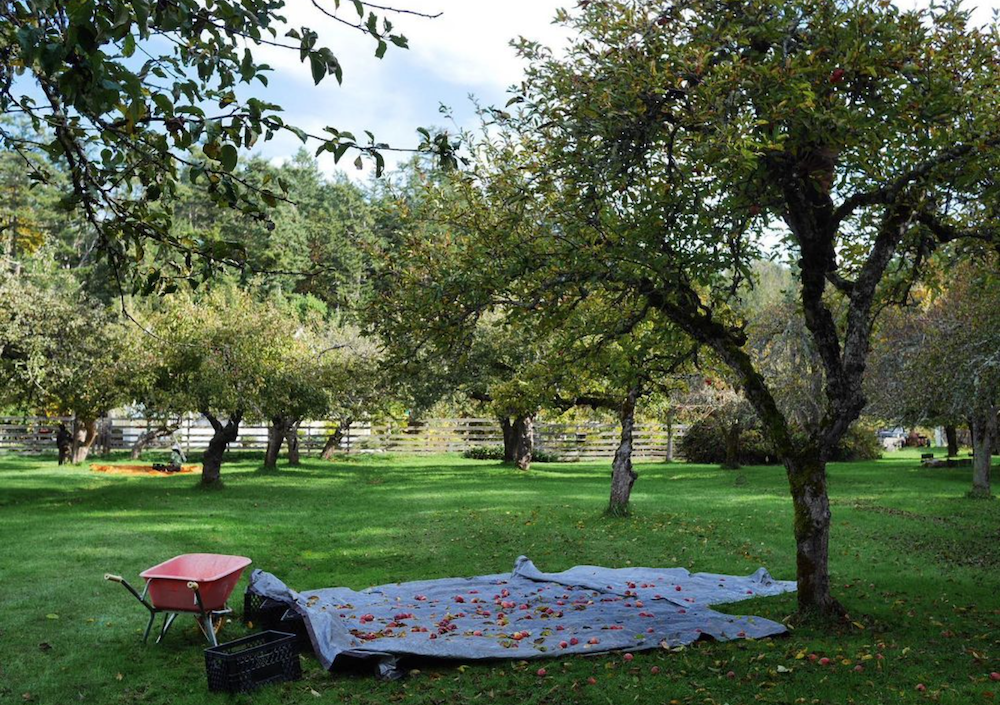rare Fruit, deep roots
The essence of a cider or perry comes from the quality and character of the fruit. The apples and pears we harvest come from various century-old orchards on Pender Island, as well as homestead orchards both new and old on Pender, Mayne, Saturna and Samuel Islands, the traditional territory of numerous Coast Salish nations. When settlers originating from Europe and Japan (among others) established homesteads here over a century ago, their first work was planting orchards of now-obscure apple varieties. These were cultivated for cooking, eating, juicing, cidermaking, and commercial export to the mainland. Much of our annual work is harvesting and pruning these now tall, sprawling, old trees around north and south Pender Islands. Many are also “wild”, chance-seedling varieties that are completely genetically unique.
Rare mixed-use varieties we use include: Golden Russet, Baldwin, King of Tompkins County, Reinette du Canada, Gravenstein, Grimes Golden, Yellow Bellflower, Belle de Boskoop, and countless others; along with traditional cider-specific varietals like Yarlington Mill, Bulmer’s Norman, Dabinett.
Natural Fermentation
Traditionally, cider and wine was fermented with the naturally occurring yeasts found on fruit skins, mills and presses, and in the air. The result was an endless diversity of aromas and flavour profiles as unique as the farms where they were made. With the later development of lab-cultivated yeasts, much of this diversity has been lost in favour of a predictable, consistent product that is easier to control.
We ferment our ciders exclusively with naturally-occurring yeasts. This low intervention process entails zero to minimal added sulphites, and the resulting ciders have incredibly layered profiles. Using apples from non-fertilized, old, full-standard trees and fermenting slowly in the cool winter season has been the key to successful natural fermentation for us.
While the process is riskier, we have found this to be the best way to convey our apples’ island terroir.
Traditional methods
We use traditional cider making methods throughout our process. At pressing and post-fermentation blending, our desire is to highlight the range of flavours different heirloom apples can express by isolating particular varieties. Apples are allowed to “sweat” after harvest, a process causing them to dehydrate slightly in the warm fall air, which decreases the yield but increases the sugars (and resulting ABV) and flavours. After milling, many of our batches are macerated (allowed to oxidize), giving the cider a richer colour and increasing the diversity of wild yeasts in the juice.
Most of our ciders are fully dry with zero residual sugar, but if sweetness is desired we employ traditional keeving methods, which involve slowing fermentation through multiple rackings. Eventually the cider stabilizes (stops fermentation) before total dryness is reached. This results in a natural residual sweetness and is in opposition to the industry standard of adding back refined sugar to sweeten cider.
Finally, when it’s time to put bubbles in the cider, our batches range from secondary in-bottle fermentations, ancestral method (pét-nat), and traditional method (disgorged bubbly), as well as the occasional still cider (no bubbles at all).
juicy press about Twin Island Cider:
Pipette Magazine From, Here: Fermentation from the Ground Up Issue 9 (print) 2021
Wine Enthusiast Magazine Natural Wine Meets Cider in These Pet-Nat Sparklers 2020
Montecristo Magazine Learning the Art of Branch-to-Bottle Craft Cider 2019
Nuvo Magazine B.C. Craft Cider Autumn 2018
Concrete Garden Magazine Local Flavour—Gulf Islands Park Reserve 2018
Cider Craft Magazine Cider Bubbles with Pet Nat 2018
The Westender Craft Cider on Cusp of Province-Wide Boom 2017


